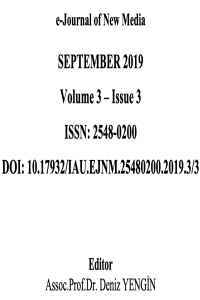Research Article
Year 2019,
Volume: 3 Issue: 3, 213 - 225, 01.09.2019
Abstract
Bu çalışmanın amacı, iş yeri maneviyatı ile çalışan performansı arasındaki ilişkiyi ve her iki olgunun
birbirini açıklama yetkinliğini incelemektir. Araştırmada 18 ifadeden oluşan, “İş Yeri Maneviyatı
Ölçeği” ile 12 ifaden oluşan “Çalışan Performansı Ölçeği” kullanılmıştır. Araştırmada anket yöntemi,
bir yerel yönetim çalışanlarına uygulanmıştır. Araştırma bulgularına göre iş yeri maneviyatı
boyutlarıyla çalışan performansı arasında olumlu ve anlamlı bir ilişki olduğu, ancak “manevi bağ” ve
“topluluk duygusu” alt boyutlarının çalışan performansı ilişkisini açıklamada yeterli olmadığı
anlaşılmaktadır.
References
- Akkoç, İ., Çalışkan, A. & Turunç, Ö. (2012). Örgütlerde Gelişim Kültürü ve Algılanan Örgütsel Desteğin İş Tatmini ve İş Performansına Etkisi: Güvenin Aracılık Rolü”, Yönetim ve Ekonomi, 19(1), 105-135. Benefiel, M.. (2003). Mapping The Terrain of Spirituality in Organizations Research. Journal of Organizational Change Management, 16 (4): 367-377. Büyüköztürk, Ş. (2011). Sosyal Bilimler İçin Veri Analizi El Kitabı (14. baskı). Ankara: PEGEM Akademi. Fleischman, P. R. (1994). The Healing Spirit: Explorations in Religion and Psychotherapy. Cleveland, OH: Bonne Chance Press. Giacalone, R. A. & Jurkiewicz, C. L. (2003). Toward a Science of Workplace Spirituality, Armonk, New York: M. E. Sharpe, Inc. Spirituality. Giacalone, R. A. and Jurkiewicz, C. L. (Editors), Handbook of Workplace Spirituality and Organizational Performance, 3-29. Hakanen, J., Bakker, A. B.& Schaufeli, W. B. (2006). Burnout and Work Engagement Among Teachers, Journal of School Psychology, 43, ss.495-513. Karakaş, F. (2010). Spirituality and Performance in Organizations: A Literature Review, Journal of Business Ethics, 94(1): 89-106. Krahnke, K., Giacalone, R. A. & Jurkiewicz, C. L.. (2003). Point-Counterpoint: Measuring Workplace Spirituality. Journal of Organizational Change Management. 16 (4): 396-405. Kinjerski, V.M. & Skrypnek, B.J. (2004). Defining spirit at work: finding common ground. Journal of Organizational Change Management, 17, 26-42 Kinjerski, Val M. & Skrypnek, B.(2006). Measuring the Intangible: Development of the Spirit at Work Scale. The Sixty-Fifth Annual Meeting of the Academy of Management, Atlanta: The Academy of Management, s. 1-16. Llorens, S., Bakker, A. B., Schaufeli, W., & Salanova, M. (2006). Testing the Robustness of the Job Demands–Resources Model, International Journal of Stress Management, 13, ss.378-391. Marques, J., Dhiman, S. & King, R. (2007). Spirituality in the Workplace What it is Why it Matters How to Make it Work for You. Personhoodpress, USA. Mauno, S., Kinnunen, U., & Ruokolainen, M. (2007). Job Demands and Resources as Antecedents of Work Engagement: A Longitudinal Study, Journal of Vocational Behavior, 70, ss. 149-171. Milliman, J., Czaplewski, A. J., & Ferguson, J. (2003). Workplace Spirituality and Employee Work Attitudes: An Exploratory Empirical Assessment. Journal of Organizational Change Management, 16 (4): 426-447. Pfeffer, J. & Salancik, G. R. (2003). The External Control of organizations: A Resource Dependence Perspective (classic edition). Stanford, CA: Stanford University Press. Saks, A. M. (2006). Antecedents and Consequences of Employee Engagement. Journal of Managerial Psychology, 21(7), ss.600-619. Sheep, M. L. (2006). Nurturing The Whole Person: The Ethics of Workplace Spirituality in A Society of Organizational. Journal of Business Ethics, 66: 357-375. Sigler & Pearson (2000). Creating An Empowering Culture: Examining The Relationship Between Organizational Culture And Perceptions Of Empowerment. Journal of Qualitiy, Elsevier. Ünal, Z. M. & Turgut, T. (2015). The Buzzword: Employee Engagement. Does Person-Organization Fit have a Contribution on Employee Engagement?, Iranian Journal of Management Studies, Vol 8(2), pp 157-179.
There are 1 citations in total.
Details
| Primary Language | Turkish |
|---|---|
| Subjects | Communication and Media Studies |
| Journal Section | Research Article |
| Authors | |
| Publication Date | September 1, 2019 |
| Submission Date | March 1, 2019 |
| Acceptance Date | May 10, 2019 |
| Published in Issue | Year 2019 Volume: 3 Issue: 3 |

